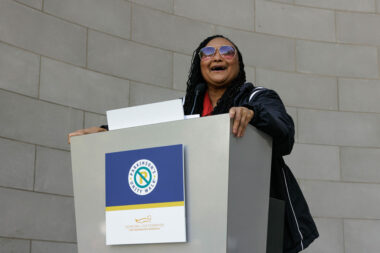Ali’s daughter takes up the ‘fight’ for Parkinson’s families
Maryum Ali shares how Parkinson's affected her late father, Muhammad Ali

Six years before world champion boxer Muhammad Ali was diagnosed with Parkinson’s disease, his young daughter noticed he was slurring his speech. It was around the time of Ali’s heavyweight championship fight against Leon Spinks.
“People thought he was ‘punch drunk’ from boxing,” the daughter, Maryum “May May” Ali, recounted in an interview with Parkinson’s News Today. “In 1978, there was nowhere near the information on Parkinson’s as there is now. A lot of people hadn’t heard of it.”
At the time, Ali was 36 and the mean age at Parkinson’s onset is typically 60 or older. By then, he had already achieved mythic status. Nicknamed “The Greatest,” the late American boxer is widely considered one of the most important sports figures of the 20th century.
While he retired three years later, in 1981, Ali’s diagnostic odyssey was just getting started.
“As Muhammad Ali, he had the best doctors and neurologists, but [Parkinson’s] was still unknown. He was misdiagnosed for six or seven years,” said Maryum, who led The Michael J. Fox Foundation’s (MJFF) 2024 Parkinson’s Unity Walk in New York’s Central Park last month.
2024 Unity Walk raised $2.2M for Parkinson’s research, public policy priorities
In its 30th year, the 1.2-mile event on April 27 had more than 5,000 participants and raised $2.2 million for Parkinson’s research and public policy priorities. More than 65,000 New York state residents live with the disorder that is significantly more well-known than it was four decades ago.
Maryum and her other siblings have been publicly sharing their family’s journey for years.
“For a while, [the doctors] thought he just had symptoms that wouldn’t progress, although they were,” she said. “He was struggling with it alone — off balance, a tremor. We were completely ignorant as to what it was.”

Maryam “May May” Ali led The Michael J. Fox Foundation’s 2024 Parkinson’s Unity Walk in New York’s Central Park. Photos courtesy of The Michael J. Fox Foundation
Parkinson’s, a progressive neurodegenerative disease, affects each patient differently and can cause a broad array of symptoms. It’s perhaps best known for its effect on movement and balance, which can create issues with rigidity, tremor, and slowed movement. Patients may also experience nonmotor symptoms that can result in problems with mental health, cognition, and sleeping.
In 1984, after years of symptoms, Ali was officially diagnosed at age 42. Maryum, the eldest of nine, was 14 at the time.
“Back then, there were no support groups, and no internet. Now the internet’s a goldmine for the disease. It’s a much different world now than it was then,” she said. “Dad didn’t even have a movement disorder specialist for two years.”
While his disease progression was relatively slow, she could see that he was struggling.
Parkinson’s brought change, judgment, isolation for Muhammad Ali
“Yes, he was the great Ali and Superman to a lot of people, but Parkinson’s was a huge change in his life. And there was a lot of judgment. Some people thought he was on drugs. I remember when we were in a crowd in Vegas and two guys were going at him, and it was really bad,” said Maryum, a social worker by trade who lives in Illinois. “So I’d see him hide and isolate himself a little bit. There were emotional and psychological changes.”
Even after he was diagnosed, the learning curve was steep. At the time, for instance, the former boxing champ didn’t understand the need for speech therapy or exercise, which has been shown to mitigate symptoms. “He was like, ‘if I don’t have a boxing ring, I’m not exercising.’ And he didn’t. But he didn’t have the information,” said Maryum.
It was Ali’s wife, Lonnie, who handled his day-to-day care. He learned from her the importance of taking his medications in a timely manner to control symptoms, for example. He also learned that, at times, medications and dosages may need adjusting.
“He was a macho guy, so he’d be embarrassed if we asked him to lift his feet when he walked, but he kept trying to understand things,” said Maryum. “We’d talk things through.”
Turning point came when Ali lit torch at 1996 Centennial Olympic Games
It was in 1996, when Ali lit the Olympic torch, a dramatic, emotional event that signaled the start of the Centennial Olympic Games, that he began to step out of his shadow.
“He found out that people still loved him, and that the more he was out in public, the more people would understand the disease,” Maryum said. “He knew he could be a mouthpiece.”
Over time, her father became increasingly less verbal. Early on, family members often “talked around him” while in his presence rather than speak directly to him, Maryum noted. Through education, they learned not to do that.
“So, when he was quiet, he’d do hand signs he’d make up, or we’d watch a Western with him. He also liked music videos and watching documentaries about himself. Sometimes we just told him about our day,” she said.
At times, her father would engage in compulsive behavior called “punding,” which can help some Parkinson’s patients soothe feelings of tension or intense curiosity. His expression of punding was ripping “pretty” pages from magazines.
“Levodopa can cause it; it’s a side effect,” Maryum said of the Parkinson’s treatment often given in combination with a medication called carbidopa. “We were educated about it and just let him do it. We’d just be loving and caring and inclusive and find ways to help him enjoy his day.”

Maryam “May May” Ali and Michael J. Fox are involved in the Unity Walk.
Parkinson’s-associated motor symptoms can affect a patient’s ability to show emotions using facial expressions. As such, Ali developed a “masked” or “frozen” facial appearance that on at least one occasion was off-putting to those he encountered, Maryum said.
“He couldn’t smile, so they thought he was mad at them. He had a kind of stoic look, and my sister had to explain to them what it was. It’s so important that families are educated.”
That’s where “wonderful” organizations such as the MJFF can help, providing patients and families with critical educational resources, as well as information about clinical trials, said Maryum, whose maternal grandfather died at 89 with Parkinson’s. After Ali’s diagnosis, his brother also developed the condition.
Scientists continue working to understand the disorder’s underlying biological mechanisms. About 5% to 10% of patients carry a known disease-causing mutation, and genetics may also play a role. Identified risk factors include a history of brain injury and exposure to certain chemicals and toxins.
He was the great Ali and Superman to a lot of people, but Parkinson’s was a huge change in his life.
Both Ali and his brother, who is still living, had been extensively exposed to lead during childhood. Their father was a sign painter and stored paints in the house, which would become permeated with fumes, Maryum said.
“What they didn’t have in common was boxing, so theoretically, it could be the lead,” she noted. “You just never know. There are so many boxers who don’t have Parkinson’s. But I personally think boxing was a contributing factor.”
After three decades with Parkinson’s, Ali died in 2016. Maryum said he never seemed to feel sorry for himself.
“He’d say, ‘I had a great life and career, so don’t be sad. I’m not in any pain.’ He was also extremely spiritual. He stayed optimistic, pretty much. That was his makeup. So, my siblings and I didn’t live with depression about it,” she said.
Maryum, who first got involved with the Unity Walk in 2002, said it’s now a new day for Parkinson’s patients and their families.
“There was a time when the Unity Walk, support, or information weren’t there,” she said. “But people have access now. They don’t have to suffer as much now.”









